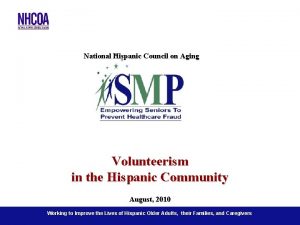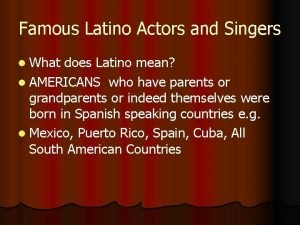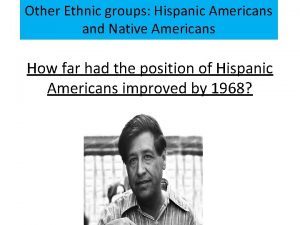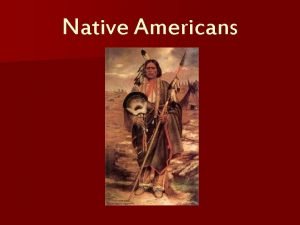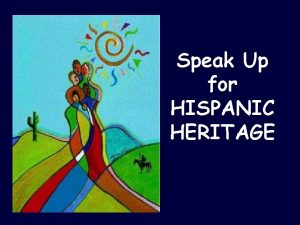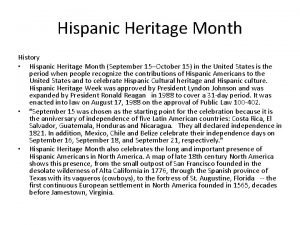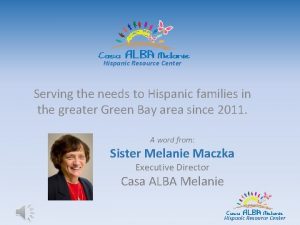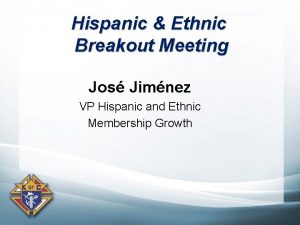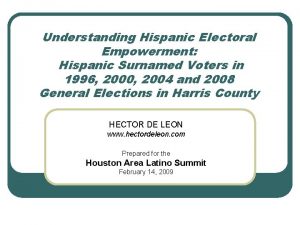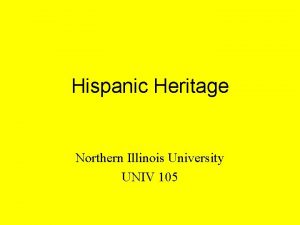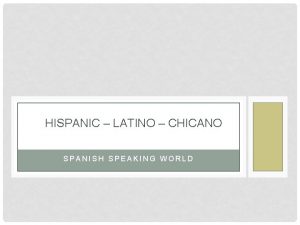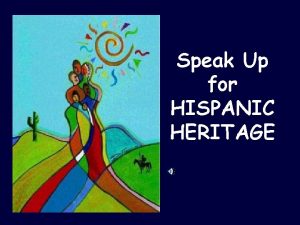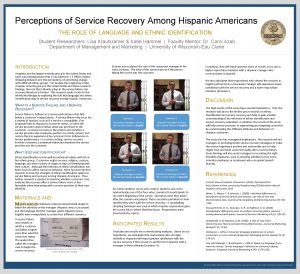HISPANIC AMERICANS Definition of Hispanic in the U

















- Slides: 17

HISPANIC AMERICANS

Definition of Hispanic in the U. S. Hispanic is a term created by the U. S. • Mexico • Puerto Rico • Cuba • Dominican Republic • Central America • Spain • Portugal

Hispanic is a Broad Term • The use of rice and beans is almost the only constant across the groups classified as Hispanic. • 63% of Hispanic Americans are of Mexican decent.

History of Mexican Americans • 30, 000 moved here after the annexation of parts of Mexico in 1848. • In the 1910’s many migrated here during the Mexican civil • Until the 1960 s, most lived within a few hundred miles of the border, although some resettled along frail lines from the Southwest to the Midwest. • More recently, Mexican Americans have diffused throughout the U. S. , especially in the Midwest and Southeast. • Mexican American largest populations are in California, Texas, Illinois, and Arizona.

Hispanic Population in the U. S.

Culture • Contemporary life in its cities has become similar to that in neighboring United States • Strong devotion to family • Hierarchy of respect for the elders • Many first-generation immigrants mistrust the government and are afraid of deportation • Preserve the Spanish language

Religion • 89% of the population are Roman Catholics. • Our Lady of Guadalupe is a Roman Catholic icon of the Virgin Mary. • She appeared to Juan Diego and asked him to build a church at that site in her honor. He told Fray Juan de Zumarraga, who told him to ask the “lady” for a miraculous sign to prove her identity. -Healed Juan’s uncle - Formed flowers into the Virgin of Guadalupe

Common Hispanic Foods • Three largest Hispanic subgroups: Cuban, Puerto Rican, Mexican. • Rice & beans • Beef, pork, goat, chicken • Spices (garlic, cilantro, basil, hot peppers) • Fruit (bananas, mangos, guava, tamarind, papayas, melons) • Vegetables (corn, carrots, potatoes, tomatoes, peppers, avocados, onions, tomatillos)

Mexican Culture • Tacos, burritos, and tamales • Some Hispanics have already adopted U. S. food practices because they are familiar with the products • Encourage traditional soups, stews with veggies and corn based tortillas • Lunch is the main meal of the day, siesta is taken after that, midday and evening meals are important family events

Tortillas • The Mexican diet is very high in carbs • Tortillas are the most common bread at meal time • Northern Mexico is known for the popular flour tortilla • Southern Mexico has thin, corn tortillas • Lard; adds flavor, makes a more pliable flour tortilla. Being replaced by vegetable oil.

Health Concerns • High in carbohydrates • Difficult for those with abnormal glucose tolerance • Choose to keep the carbohydrates that are most important

Disease Risks • Heart Disease • 2 of every 3 Latinas are overweight • 60% of Latinas are physically inactive • Diabetes • 1 in 10 adult Latinos have diabetes

Nutritional Concerns • Tortillas • Made with lard • Concerns with heart disease and diabetes • Eaten at most meals

Nutritional Implications • Fairly balanced diet • Meat: pork, beef, goat • Grains: Rice, Corn, Pastas • Vegetables: Carrots, Green Beans, Greens • Fruits: Mangos, Papayas, Tomatoes • Most Mexican pastries have less fat and sugar than U. S. pastries • Many even made with whole wheat flour

Communication Style • Use formal terms • Greet with a handshake • Be in close proximity during conversation • Use gestures • Touching and physical contact is normal • Avoid prolonged eye contact • Encourage questions

Interacting in the Workplace • Get to know them on a personal level • Be ready and willing to shake hands • Be a leader not a “boss”

Uniqueness of the Individual • Country of origin • Education • Income level • Access to healthcare • Language skills • Family support
 Hispanic cultural views on teenage pregnancy
Hispanic cultural views on teenage pregnancy National hispanic council on aging
National hispanic council on aging Hispanic american scientists
Hispanic american scientists Is hispanic an ethnicity
Is hispanic an ethnicity Servingness
Servingness Domestic violence in the hispanic community
Domestic violence in the hispanic community Most famous hispanic artists
Most famous hispanic artists Hispanic dude
Hispanic dude Gloria estefan married to emilio estevez
Gloria estefan married to emilio estevez Hát kết hợp bộ gõ cơ thể
Hát kết hợp bộ gõ cơ thể Slidetodoc
Slidetodoc Bổ thể
Bổ thể Tỉ lệ cơ thể trẻ em
Tỉ lệ cơ thể trẻ em Chó sói
Chó sói Chụp phim tư thế worms-breton
Chụp phim tư thế worms-breton Hát lên người ơi alleluia
Hát lên người ơi alleluia Môn thể thao bắt đầu bằng từ đua
Môn thể thao bắt đầu bằng từ đua Thế nào là hệ số cao nhất
Thế nào là hệ số cao nhất

